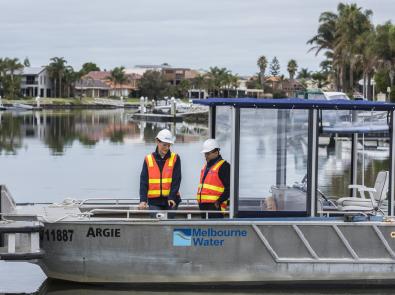Automating our business’s operations is a key focus. In many instances, employing new technology that automates inspection and operational processes has proved not only cost effective, but also increased staff safety and helped protect the environment and our communities. Read the case study to learn more.
Sustainable Development Goals:
Goal 9: Industry, innovation and infrastructure
Background
An example of automation is the operation of flood gates at Patterson Lakes, in Melbourne’s outer south-east.
These flood gates separate the tidal waterways and town centre marina from Patterson River and are designed to protect the area’s 1,400 residents, their properties and local roads from flooding. The tidal gates open during normal weather conditions so that boats can access the river, but close when river levels are high.
Project focus
Traditionally, our staff have had to visit the site to manually close the gates to prevent flooding, often in the dark and during bad weather. This process is not only potentially risky to our operators, but also costs valuable time while flood waters may be making their way upstream.
A new automated system will allow the gates to close remotely as soon as we receive an alert about potential flood conditions.
Outcomes
This instant response will mean reduced chances of floodwater entering the tidal canal system as well as lowering our labour costs, improving staff safety, and helping to protect homes and businesses close to the river.
You may also like...
Delivering on the Sustainable Development Goals
This report outlines Melbourne Water's unwavering commitment to advancing sustainability through the United Nations Sustainable Development Goals (SDGs).




